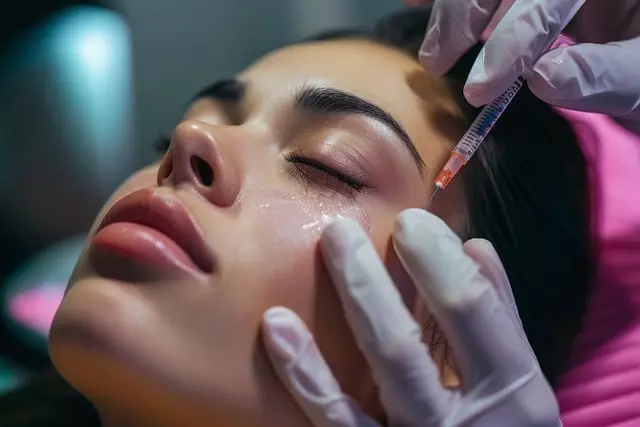Botox has emerged as a leading non-surgical treatment for facial contouring, particularly jawline tightening. By injecting botulinum toxin into specific muscles along the jawline, it relaxes them, smoothing the surrounding skin and redefining contours over time. This procedure is minimally invasive, with customizable results, minimal downtime, and natural appearances. Despite safety considerations and potential side effects, careful patient selection, accurate dosing, and expert administration minimize risks. The ideal provider should specialize in facial esthetics, demonstrating a history of achieving natural-looking results and maintaining symmetry. Botox for facial contouring offers significant improvements in jawline tightening, lasting several months, making it a preferred alternative to surgery due to its non-invasive nature and targeted approach. Future trends include advanced neurotoxins, fillers, and new technologies, promising more natural, subtle enhancements.
“Uncover a non-surgical solution for achieving a tighter, more contoured jawline with Botox for facial contouring. This innovative approach to rejuvenating the lower face has gained popularity due to its minimal downtime and remarkable results.
In this comprehensive guide, we’ll explore ‘Botox for Jawline Tightening’, delving into the science behind it, its benefits, procedure, safety, and choosing the right expert. From understanding the mechanics of Botox to witnessing incredible patient transformations, get ready to discover a potential game-changer in non-surgical facial rejuvenation.”
Understanding Jawline Relaxation with Botox

Botox has emerged as a popular and effective non-surgical treatment for facial contouring, particularly when it comes to jawline tightening. Understanding how Botox works on the jawline is crucial for those considering this aesthetic procedure. The process involves injecting a small amount of botulinum toxin into specific muscles along the jawline, which over time relaxes these muscles and smoothens out the surrounding skin. This relaxation effect leads to a more defined and contoured jawline, reducing the appearance of jowls and improving overall facial balance.
When used for facial contouring, Botox targets the masseter and temporal muscles, responsible for chewing and facial expressions. By temporarily paralyzing these muscles, Botox for jawline tightening can create a slimmer, more angular look without impacting one’s ability to chew or speak normally. This procedure offers a non-invasive alternative to surgical facial rejuvenation, appealing to individuals seeking subtle yet noticeable enhancements.
The Science Behind Botox and Its Effects on the Face

Botox, a natural protein produced by bacteria, has found its way into the world of aesthetics as a powerful tool for facial contouring. When injected into specific muscles, Botox relaxes them, leading to a reduction in dynamic wrinkles and changes in facial structure over time. In the case of jawline tightening, Botox is strategically placed in the masseter and temporal muscles, responsible for chewing and jaw clenching, respectively. This non-invasive procedure offers a temporary yet effective solution for those seeking to enhance their facial features without surgery.
The effects of Botox on the face extend beyond wrinkle reduction. By relaxing overactive muscles, it can redefine facial contours, creating a more chiseled appearance, particularly along the jawline and neck. This innovative approach to facial contouring has gained popularity due to its minimal downtime, natural results, and ability to provide a more balanced and youthful visage. Botox for facial contouring is a non-permanent solution, requiring touch-ups every few months to maintain the desired effects, making it an accessible option for those looking to enhance their beauty regimen.
Benefits of Using Botox for Jawline Tightening

Botox has emerged as a popular and effective non-surgical procedure for facial contouring, particularly focusing on jawline tightening. This treatment offers several advantages over traditional surgical methods. One of the key benefits is its minimal invasiveness; it involves injecting a small amount of Botox into specific muscles along the jawline, which leads to a gradual and natural-looking firming effect without any incisions or extensive recovery periods.
Additionally, Botox for facial contouring provides a highly customizable approach to aesthetics. Through precise injections, practitioners can target problem areas, enhancing facial balance and reducing the appearance of jowls or a double chin. This method is especially appealing to those seeking a more defined jawline without the risks and downtime associated with surgery.
The Procedure: Step-by-Step Guide to Botox Injection

The procedure of using Botox for jawline tightening involves a series of precise injections to target specific muscle groups responsible for jutting or sagging jawlines. It is a non-surgical, minimally invasive approach to facial contouring, making it an attractive option for those seeking subtle yet effective enhancements.
Step one begins with a consultation where a board-certified dermatologist assesses your facial structure and identifies the areas requiring treatment. The next step involves cleaning and preparing the skin while the practitioner uses fine needles to inject Botox into the targeted muscles along the jawline. This process is carefully measured to avoid any discomfort, ensuring minimal downtime for patients. After the injections, light swelling or bruising may occur, but these typically subside within a few days, revealing a firmer, more contoured jawline.
Safety and Potential Side Effects of Botox Treatment

When considering Botox for facial contouring, particularly jawline tightening, it’s crucial to weigh the potential benefits against safety considerations. Like any medical procedure, Botox treatments carry risks and side effects that should be thoroughly understood before proceeding. While Botox is generally safe when administered by a qualified professional, there are possibilities of adverse reactions. These can include temporary redness, swelling, or discomfort at the injection site, as well as more systemic reactions like headaches or nausea.
In rare cases, Botox may cause significant side effects such as difficulty swallowing, muscle weakness in the face or around the mouth, or even more severe allergic reactions. It’s essential to discuss these risks openly with your healthcare provider and to be aware of any unusual symptoms that could indicate a reaction after treatment. Proper patient selection, accurate dosing, and expert administration are key factors in minimising potential side effects associated with Botox for facial contouring procedures.
Choosing the Right Provider for Your Facial Contouring Needs

When considering Botox for jawline tightening and facial contouring, choosing the right provider is paramount. It’s important to look beyond certifications and experience, focusing on specialists who understand the nuances of facial esthetics. Seek providers who have a proven track record with before-and-after results, showcasing their skill in achieving natural-looking enhancements without compromising facial symmetry.
Research their approach to Botox injections for jawline tightening, ensuring they tailor treatments to individual needs. Consider patient reviews and testimonials to gauge satisfaction levels and the overall patient experience. A reputable provider should offer comprehensive consultations, addressing your concerns, dispelling myths, and setting realistic expectations, making you feel at ease throughout the process.
Patient Success Stories: Before and After Results

Many patients seeking jawline tightening and facial contouring have found success with Botox injections. The before-and-after results speak for themselves, showcasing significant improvements in facial definition and a more sculpted appearance. In one notable case study, a 35-year-old patient expressed dissatisfaction with their rounded jawline, which made them feel self-conscious about their facial structure. After receiving Botox treatments focused on the masseter muscles, visible changes emerged within weeks. The patient’s jawline became more angular and defined, enhancing their overall facial symmetry and boosting their confidence.
Similar success stories are not uncommon, with patients reporting reduced facial fat and a tighter, more contoured jawline. These results can last for several months, providing a non-invasive and effective alternative to surgical procedures. Botox for facial contouring has gained popularity due to its minimal downtime, natural-looking outcomes, and ability to address specific areas of concern related to facial structure and symmetry.
Future Trends in Non-Surgical Facial Rejuvenation

The future of non-surgical facial rejuvenation looks promising, with a growing emphasis on natural, subtle enhancements. As technology advances, we can expect to see more innovative treatments that build upon the success of Botox for facial contouring. One emerging trend is the use of advanced neurotoxins and fillers that offer longer-lasting results while reducing downtime. These developments aim to enhance overall facial harmony without drastic procedures.
Additionally, personalized treatment plans are gaining popularity. Treatments will be tailored to individual needs, taking into account skin type, age, and desired outcomes. This approach ensures optimal results and patient satisfaction. With continued research, we might also see the integration of new technologies, such as plasma therapy or advanced light-based treatments, into non-surgical facial procedures, further revolutionizing the industry.
